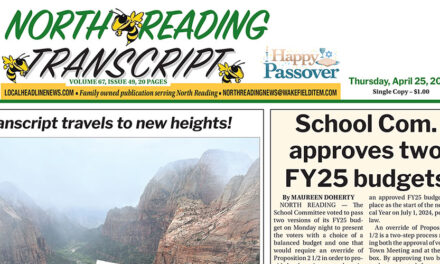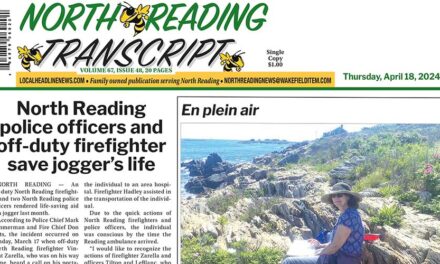Published in the November 19, 2015 edition
By BOB TUROSZ
NORTH READING — The town’s new property tax rate for fiscal 2016 as voted by the Board of Selectmen will be $16.41 per thousand valuation, a modest drop of 21 cents, but most taxpayers will will still see an increase in their tax bills because property assessments have increased.
Acting at their annual tax classification and rate setting hearing Monday night, the Selectmen voted to maintain a single tax rate for all residential, commercial and industrial properties, something the town has had every year since 1988. North Reading has split the tax rate only other time, in 1985.
The average residential property in town is now valued at $502,195, a 4 percent increase from 2015, when the average value was $482,670. At the new tax rate, the “average” residential bill for a single family home will be $8,200. Based on the Board of Assessors’ recommendations, which were adopted Monday night, North Reading’s tax levy for fiscal 2016 will be $45,817,464, about $12,424 less than the absolute limit mandated by Proposition 2 1/2.
The tax rate setting hearing is a yearly legal requirement the Selectmen must act on and this year’s meeting was a lengthy but comparatively subdued affair without disagreement about whether there should be a split tax rate favoring residences over business property. The answer to that was No.
A little over 87 percent of the town’s tax base is residential, leaving less than 13 percent commercial and industrial. These numbers haven’t budged in years and explain the Selectmen’s ongoing efforts to beef up the town’s commercial/industrial sector by attempting to attract new development. Given the current 87–13 split, members felt it would be counterproductive to shift a higher percent of the tax burden onto business property when the town is actively attempting to encourage commercial development.
Chief Assessor Deborah Carbone and Finance Director Liz Rourke gave a very detailed PowerPoint presentation on all things financial that answered many questions usually raised by the board members. About half of the 90 minute hearing was spent in minute discussion of the so–called “Income and Expense” forms that businesses are required to file and new methods to encourage 100 percent compliance in returning the forms. North Reading mailed out 287 income and expense reports, Carbone said, and 176 reports were returned, a rate of over 60 percent. This represents a big improvement from fiscal 2012, when only 40 percent were returned.
Carbone credited the increase return rate to a $250 fine her office now imposes on businesses that don’t return their forms. This amounted to $27,750 in fines this year, she said. But Selectman Stephen O’Leary commented it might actually be cheaper for businesses to pay the fine rather than complete and return the form, which could increase their taxes.
Lisa Egan, Executive Director of the Reading – North Reading Chamber of Commerce, urged the Selectmen to maintain a single tax rate. Egan said she’s been working with the town’s Economic Development Commission and Planner Danielle McKnight and sees “exciting” economic development coming. A single tax rate will help stimulate commercial growth, resulting in a bigger tax base to ease the burden from homeowners. At only 13 percent of the tax base, commercial and business owners would be affected disproportionately by any shifting of the tax burden, she said.
John Barrette, 2 Dogwood Lane, commented he’s lived in town seven years and has seen an increase of about 30 percent in his property taxes. “The population in general is not experiencing this growth in income,” he said.
Selectman Chairman Robert Mauceri explained that Proposition 2 1/2 limits the increase in the town’s revenue to 2 1/2 percent every year, plus “new growth” from new construction and new business. The new high school is being funded above the levy limit until that debt is paid off after 20 years. Barrette noted a commercial entity wouldn’t be able to budget to the revenue limit year after year and asked the rationale for that. Mauceri replied the 2 1/2 percent annual growth doesn’t cover all the town’s expenses. The school department, for example, regularly sees annual growth of about 4 percent and the town has little or no control over fixed costs, like debt service and employee benefits.
Michael Prisco said the board has concluded the only way out of this box is for the town to expand its commercial base and they have started taking the steps to realize that. “We’re fully committed to that and we know the taxpayers in this town have really been feeling the pinch.”
After listening to the public input and the presentation, the board voted in a series of unanimous 5–0 votes to:
• Tax all property in town – residential, commercial and industrial – at the same rate.
• Against establishing a residential tax exemption of up to 20 percent that would shift the residential class tax burden from lower assessed, owner–occupied properties to higher assessed properties that are not the principal residence of a taxpayer. Reason: this exemption is really meant for resort communities like Cape Cod, not North Reading.
• Not to establish a small commercial exemption of up to 10 percent that would work in much the same was as the residential exemption. Again, the shift in the tax burden would fall on higher–valued commercial and industrial properties.
• Not to establish an open space discount. This one was easy. According to Carbone, North Reading doesn’t have any property that meets the legal definition to qualify for a discount.
• The Selectmen recommended the fiscal 2016 property tax levy at $45,817,464, which is $12,424 less than the levy limit. “Just to let people know, we’re leaving some money on the table,” joked Selectman Stephen O’Leary.
• The Selectmen recommended to the Board of Assessors that the fiscal 2016 tax rate be set at $16.41 per thousand valuation.
There are 5,335 residential properties in town. There are 225 commercial properties and 85 industrial parcels of land.
Once the tax rate is approved by the Department of Revenue, all bills will be in the mail before January 1.




